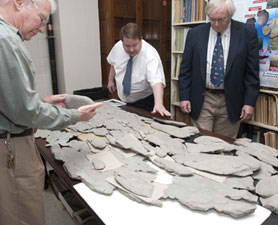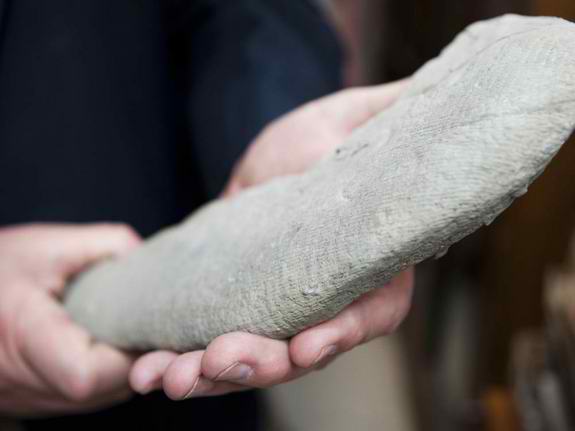It looks like you're using an Ad Blocker.
Please white-list or disable AboveTopSecret.com in your ad-blocking tool.
Thank you.
Some features of ATS will be disabled while you continue to use an ad-blocker.
7
share:
This is one of those stories that makes you go ??????

news.discovery.com...
It's always exciting when evidence of ancient life comes to light, especially when there is mystery attached to it. Without further information it's hard to give much of an opinion on what this fossil might be. Hopefully some more detailed pictures will become available so that we can see for ourselves what's so mysterious about this fossil.
www.foxnews.com...
digg.com...

news.discovery.com...
Is it animal, vegetable or mineral -- or something else entirely?
The collective brainpower of several dozen scientists was unable to unravel the mystery of a strange beast nearly half a billion years old, tentatively nicknamed “Godzillus.”
Ron Fine, an amateur paleontologist from Dayton, Ohio, hoped the supersmart group of scientists at a regional meeting of the Geological Society of America could help explain the baffling find he made recently: the fossil of a very large, very mysterious "monster" that lived near Cincinnati 450 million years ago.
Unfortunately, the sea beast of Cincinnati had them scratching their heads, too.
“Everybody else was just as puzzled as we are -- and personally, I think that’s pretty awesome,” Fine told FoxNews.com.
He found the fossilized specimen last summer, a roughly elliptical shape with multiple lobes totaling almost 7 feet in length. It dates from almost half a billion years ago, when a shallow sea covered Cincinnati.
And despite its size, no one has ever found a fossil of this “monster” until its discovery by the amateur paleontologist last year.
But neither Fine nor the other members of the Dry Dredgers, an association of amateur paleontologists based at the University of Cincinnati that has a long history of collaborating with professional scientists, could explain what it is.
“We all have a theory, that’s the problem! We’re considering both animal and plant,” Fine told FoxNews.com. “We know it’s a fossil, something that was alive. But it’s so different than anything else, we can’t tell if it's animal or plant.”
David L. Meyer of the University of Cincinnati geology department -- and co-author of "A Sea without Fish: Life in the Ordovician Sea of the Cincinnati Region" -- is able to whittle it down a little, though he remains just as baffled.
“In general, we’re heading toward this being some sort of microbial structure that was preserved on the sea bottom, and it preserved some unusual patterns in the rock,” he told FoxNews.com.
It's always exciting when evidence of ancient life comes to light, especially when there is mystery attached to it. Without further information it's hard to give much of an opinion on what this fossil might be. Hopefully some more detailed pictures will become available so that we can see for ourselves what's so mysterious about this fossil.
www.foxnews.com...
digg.com...
edit on 4-5-2012 by isyeye because: (no reason given)
Here's a closer picture of the fossil.

www.livescience.com...

www.livescience.com...
The fossil's size, shape and texture stood out from the layer of rock in which it was found. Its texture was a particularly telltale sign of a living organism — the fossil was covered in mini-ripples, sort of like wrinkles or corrugation, Meyer said.
Very interesting indeed!
Would be hilarious if it was just rocks and they're scratching their heads over nothing
Would be hilarious if it was just rocks and they're scratching their heads over nothing
You know what's funny...people find this type of stuff and thats cool. Now me...I would have stepped all over that thing and never thought twice
about it being anything more then a rock or solid mud.
Multi-lobed elliptical organism with similarities to both plants and animals, dating to an extremely long time ago. Is anyone else seeing an Elder
Thing here?
It's an interesting find, to be certain! Not sure I agree with their ideas of some mass or plant thing, though. Looks more like skin texture to me.
Be cool if they could find some bones.
new topics
-
Feng Shui…
Health & Wellness: 3 hours ago -
Elon Musk to Make Games Great Again - XAI_GAMES Announcement Incoming.
Video Games: 5 hours ago -
North Korea in Ukraine conflict???
World War Three: 5 hours ago -
Most Complex Backyard Rube Goldberg Machine You'll See All Day
General Chit Chat: 6 hours ago
top topics
-
Most Complex Backyard Rube Goldberg Machine You'll See All Day
General Chit Chat: 6 hours ago, 7 flags -
North Korea in Ukraine conflict???
World War Three: 5 hours ago, 5 flags -
Feng Shui…
Health & Wellness: 3 hours ago, 5 flags -
Elon Musk to Make Games Great Again - XAI_GAMES Announcement Incoming.
Video Games: 5 hours ago, 4 flags
7
